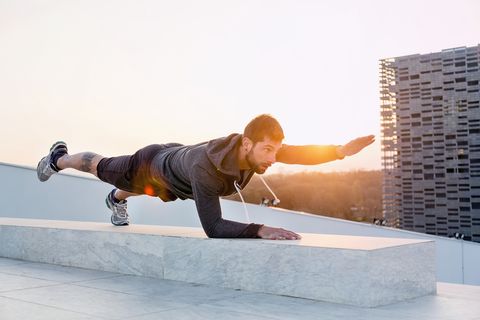
If you’re like most guys, you probably don’t associate yoga with the weight room.
But you may be surprised how much a few simple yoga poses can seriously improve your overhead lifting technique, improve your postural alignment, and protect your shoulders and back from injury.
Yoga began in India circa 3000 B.C. as a practice to find harmony between mind and body. In the thousands of years since then, the exercise has evolved and branched into many new styles that can benefit just about every person and every body — and be applied in even more areas outside of just the studio.
The many health benefits of yoga go way beyond the common misconception that it’s just a glorified stretching routine. Regular practice can help to improve the strength and flexibility of the musculoskeletal system, while also targeting the cardiovascular system, and helping to lower blood pressure and cholesterol. A vinyasa flow class, for example, will work all of your muscles — including those essential for posture and movement in your core, hips, and shoulders — while also increasing circulation and challenging your balance and flexibility.
Why Yoga Makes Sense for Weightlifters

Getty ImagesInnocenti
How does this apply to lifting heavy weights? Overhead lifting requires multiple muscles in the shoulders and surrounding area to be strong and functional. It also requires good mobility of the thoracic spine.
To raise your arms overhead, you want your shoulder blades (or scapulae) to rotate upward, allowing your arm at the shoulder joint (glenohumeral joint) to rotate smoothly and without pain. Multiple structures, such as the biceps tendons, can get pinched and inflamed if this movement is impaired.
Adding exercises that challenge the muscles of the upper back and shoulders while also improving postural alignment is critical to healthy and safe movement — especially as more weight is added to those power lifts.
So before you think you’re too manly to do a sun salutations, get yourself to a yoga class and see how tough you feel after a few warm up sequences. You’ll be surprise what using only your body weight and a yoga mat can do for your body. If you need a mat, check out this smart option that rolls itself up and is 4 inches longer than most anything else you’ll find in a yoga studio.

The Overhead Lifter’s Yoga Series
If you’re not sure where to begin, try incorporating these 5 classic poses (no flexibility required) into your strength training plan for a better shot at safe lifting.
Chair pose
This is a great yoga poses for activating the thoracic extensors and lower trapezius muscles — all important for postural alignment and shoulder stability. It also incorporates a squat, targeting the all important muscles of the hips. If you look carefully, it might remind you of the position you get into when performing a snatch or a clean and jerk.
The reason this pose is so beneficial is because it activates multiple scapular muscles while focusing on improved thoracic extension all while grounding your body through your feet and stabilizing at the hips. Try holding a chair post for 30 seconds (without any weight) and you’ll see why you need this one.
Downward Facing Dog
Possibly the most well-known yoga pose, downward dog is a classic for good reasons. This position also requires the arms to be up overhead activating those overhead lifting muscles such as the serratus anterior and lower traps.
Unlike chair pose, which is an open kinetic chain upper extremity exercise, down dog is a closed kinetic chair, creating a neuromuscular component for increased stability at the joint.
Upward Facing Dog
Up dog, performed with hands on the floor and head and chest facing upward, requires a lot of scapular retraction and depression — in other words, bringing the shoulder blades back and sliding them down towards your hips, away from your ears.
By pressing the hands into the floor and lifting from the chest while keeping the shoulder blades down and back, you are essentially unfolding your shoulders from the position they are in all day. This simple movement activates the muscles that will help stabilize the shoulder joint and improve postural alignment when heavy weight is added.
Cobra pose
Cobra pose is another great move for opening up and stretching the abdominal and pec muscles while mobilizing the thoracic spine. It is slightly more grounded than upward facing dog, but hits all the same muscles in a position that can potentially be held a little longer.
Warrior 3 pose
Warrior 3 pose works the shoulders and core while incorporating the added challenge of unilateral balance.
Even though you will most likely be standing on both feet while lifting, having that unilateral stability can further improve your foundation as you prep to lift more — and any heavy upper body lifting routine requires a good, strong foundation. This pose also incorporates the reach and activation of the thoracic extensors that is critical for healthy and strong overhead lifting.
Source: Read Full Article
